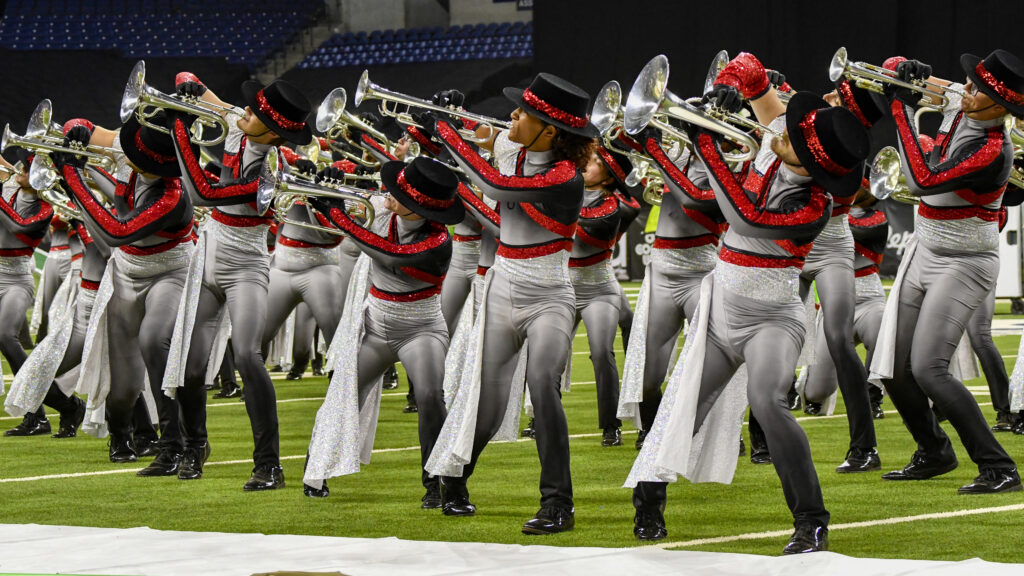Drum Corps International hosted the 2005 Division II & III World Championships at Marciano Stadium in Brockton, Massachusetts, 18 miles away from the Division I Championship at Gillette Stadium in Foxboro.
In a new format, three separate events were held in Brockton; Prelims, Class Finals, and Grand Finals, the latter pitting together in competition the top three highest corps each from Division II and Division III, plus the next six highest-scoring corps regardless of division. This in effect was a forerunner of the Open Class format that was to commence three years later. Grand Finals was held during the morning and afternoon of Division I Finals, a day that witnessed a temperature breaking the August 13 record that had stood for 101 years.
The top seven corps in the Grand Finals all came from the ranks of Division II, with East Coast Jazz ultimately topping the Spartans who took first place two days earlier. Blue Stars, two years away from re-entering World Class competition, placed third over Florida’s Teal Sound by eight tenths of a point. Fever and Impulse placed fifth and sixth, each breaking 90 points, followed by the Jersey Surf in seventh place and then the Division III Champion Raiders.

Finishing in 10th place, the international corps Taipei Yuehfu won the Division III Prelims by 1.350 points over the Raiders, but in Finals lost the title by 0.15 due to a half point penalty assessed for going overtime. The corps previously came to the DCI World Championships in 2000, 2001, and 2002, then returned in 2013.
The name Yuehfu came from that of the ancient Imperial Chinese government bureau charged with collecting and preserving a vast collection of Chinese musical literature. Honoring its home, the corps performed a show titled, “Dreams of Formosa.” Formosa was the original name of the Chinese island of Taiwan, dating from 1542 when Portuguese sailors used the name, meaning “beautiful island,” on their navigation maps. Taipei is the island’s capital and largest city.
The show started with three selections from the 2004 film, “Lemony Snicket’s A Series of Unfortunate Events,” which starred Jim Carrey. Thomas Newman, known for his work on movies such as “Scent of a Woman,” “The Shawshank Redemption,” and “American Beauty,” among many others, wrote the film’s score.

The first selection from the movie was “Regarding the Incredibly Deadly Viper,” a slow opening fanfare that built in volume over its duration of just over a minute followed by “Taken by Surpreeze,” which came from a mysterious sounding selection near the end of the movie.
The final selection from the film was “Hurricane Herman,” set during a scene depicting a massive storm. This segment started out fairly calm then built up intensity, as did the storm, leading into an extended drum feature reflecting the vigorous nature of the destructive gale.
The musical source of the percussion break was not from the movie, but provided a transition to the Chinese music that was to follow by utilizing percussion instruments native to the corps’ homeland, like a small handheld gong, piercing hand cymbals, and a large drum akin to a Japanese taiko drum. During this drum feature, members of the horn line broke out individual red Chinese fans as the color guard members performed tumbling gymnastic maneuvers.

The second part of the show started with film composer Chou Lan-ping’s “Green Island Serenade” of 1954. The piece reflected the thoughts of prisoners sent to the penal colony during a time of martial law enacted by the Chinese Nationalist Party. Chou is perhaps best known for his work, “The Butterfly Lovers,” and is regarded as the first Taiwanese composer to make an impact on the island’s music during the time immediately after World War II. This marked a period when the island’s music was still largely influenced by the pop culture of Hong Kong. The song has since become a hit among Chinese communities throughout Southeast Asia.
The plaintive melody based on the pentatonic scale started with a trumpet solo expressing the aspirations of the incarcerated. Eight members of the color guard picked up bright pink hand fans, with others waving long turquoise banners. The ones with the fans formed a continuous motion that undulated like a wave traveling across the ocean.
Peter Buffett’s “Spirit Dance” provided the corps’ closer, which is a piece composed by the keyboardist son of famed investor Warren Buffett. The work came off the 1997 album of the same name by Buffet and the New World Ensemble, largely an original blend of New Age ambience and Native American influences that were woven into a tapestry of jazz and musical reflections on modern urban life.
Another percussion break led into the final elongated section of the production, which rapidly wound down amidst the sound of Chinese drums and handheld percussion, heading toward the show ending of the guard on either red or yellow hand fans, tightly congregated together in a sudden burst of color as if a suddenly blossoming flower.

Michael Boo was a member of the Cavaliers from 1975-1977. He wrote about the drum corps activity for more than 35 years while serving as a staff writer for various Drum Corps International projects. During his lifetime Boo wrote for numerous other publications including an honors-winning book on the history of figure skating. He also was an accomplished composer. Boo passed away in 2020 and was inducted into the DCI Hall of Fame posthumously in 2021.





